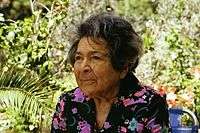Anna Ticho
Anna Ticho (Hebrew: אנה טיכו) (October 27, 1894 – March 1, 1980) was a Jewish artist who became famous for her drawings of the Jerusalem hills.
Anna Ticho | |
|---|---|
אנה טיכו | |
 | |
| Born | October 27, 1894 Moravia, then part of the Austro-Hungarian Empire (today Czech Republic) |
| Died | March 1, 1980 |
| Citizenship | Israeli |
| Spouse(s) | Avraham Albert Ticho |
Biography
Anna Ticho was born in Brno, Moravia, then part of the Austro-Hungarian Empire (today the Czech Republic) in 1894. At the age of 15, she began to study drawing in Vienna in an art school under the directorship of Ernst Nowak.[1]
In 1912 she emigrated from Vienna to what was then the Mutasarrifate of Jerusalem in the Ottoman Empire with her mother, Bertha, about four months after her fiancé, ophthalmologist Avraham Albert Ticho (1883–1960), who was her first cousin. The two married on November 7, 1912, in Jerusalem and they settled in their home above the Lemaan Zion Eye Hospital, the hospital which Dr. Ticho had reopened four months earlier. Anna worked as her husband's assistant.[2]
The Tichos were exiled to Damascus in December 1917, just days before the British conquest of Jerusalem. There Dr. Ticho entered active service as a medical office in the Austro-Hungarian Empire and Anna worked as a nurse. She developed a severe case of typhus and during her recovery, Anna Ticho returned to her art by sketching landscape scenes, foreshadowing later mastery of this genre.[3]
Via a long and circuitous route after the war, the Tichos returned to Jerusalem in December 1918 where Dr. Ticho established a private clinic and hospital, just to the north of the ruined Lemaan Zion building.[4]
In 1924, the couple purchased a large house surrounded by gardens where they lived and worked. The mansion was built around 1864, apparently for the Nashashibis, a prominent local family.[5] The house had previously been lived in by antiquities dealer and forger Wilhelm Moses Shapira.[6] The Tichos hosted local and British government officials in her home, as well as many artists, writers, academics and intellectuals. Toward the end of her life, she willed the house, her art collection, including many of her own works, and her husband's extensive Judaica collection to the city of Jerusalem.
Anna Ticho had several solo exhibitions in Mandatory Palestine and in Europe during the 1920s, 30s and 40s.[7] An even greater number of her individual exhibitions took place in the years following World War II.[8]
She died on March 1, 1980. Ticho House operates today as a branch of the Israel Museum, and houses a popular restaurant and cafe.
Artistic themes
While the dramatically different light of the Middle East and the starkness of the landscape inhibited her artistic pursuits at first, in the 1930s Ticho went back to drawing and painting. It was then that she produced many of the distinctive drawings of the hills of Jerusalem and portraits of local people for which she became well known. Today, Ticho's drawings and watercolors can be found in major museums around the world.
Awards
- In 1970, Anna Ticho received the Yakir Yerushalayim (Worthy Citizen of Jerusalem) award.[9]
- In 1980, she was awarded the Israel Prize, for painting.[10]
- Sandberg Prize recipient
See also
References
- Reifler, David M. Days of Ticho: Empire, Mandate, Medicine, and Art in the Holy Land. Jerusalem: Gefen Publishing House, 2015/5775, p 22. ISBN 978-965-229-665-8.
- Reifler. Days of Ticho, p 81.
- Reifler. Days of Ticho, p 181.
- Reifler. Days of Ticho, p 198.
- "Jerusalem Attractions". The New York Times. Archived from the original on 2007-10-29.
- Reifler. Days of Ticho, p 248.
- Reifler, Days of Ticho, p 466.
- Salmon, Irit. Anna Ticho, 1894-1980. Jewish Women: A Comprehensive Historical Encyclopedia. Retrieved January 4, 2015.
- "Recipients of Yakir Yerushalayim award (in Hebrew)". Archived from the original on 2013-10-22. City of Jerusalem official website
- "Israel Prize Official Site – Recipients in 1980 (in Hebrew)".
External links
- "Anna Ticho". Information Center for Israeli Art. Israel Museum. Retrieved 1 February 2012.
- Anna Ticho collection at the Israel Museum. Retrieved February 2012.